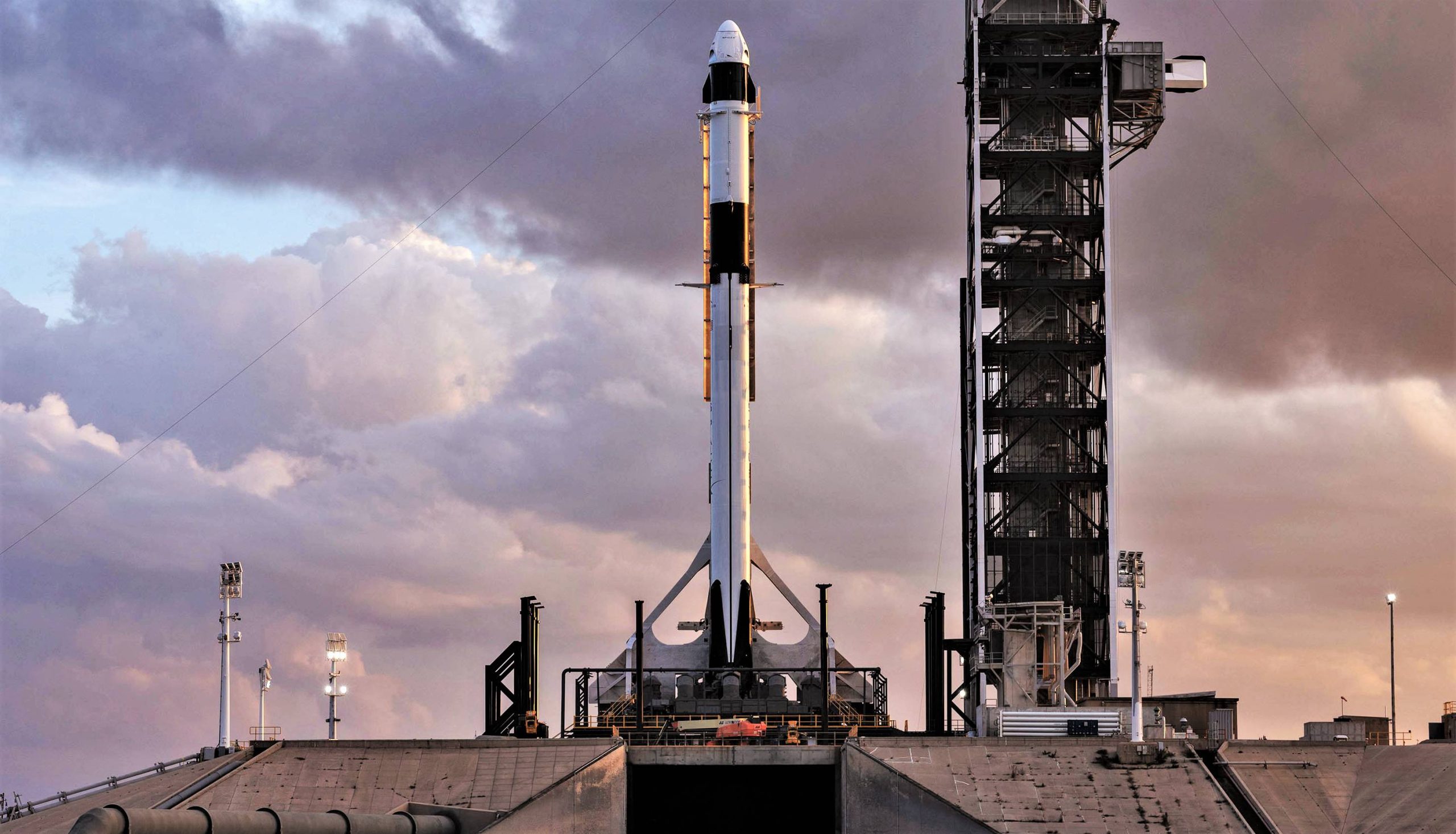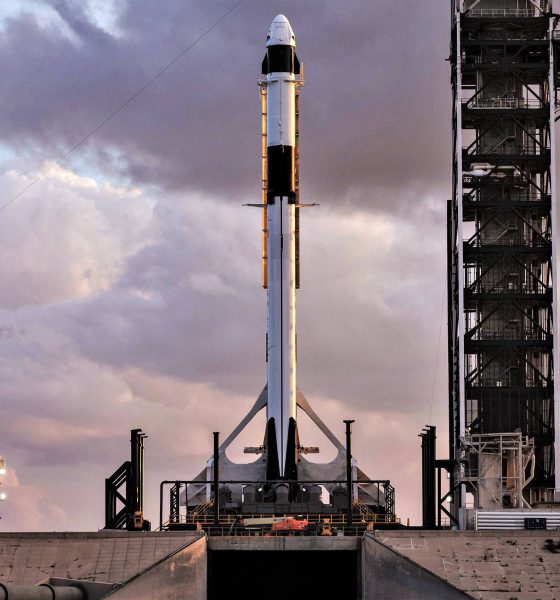

News
SpaceX hot-fires Falcon 9 with Crew Dragon aboard prior to first orbital launch
SpaceX has completed a hot-fire test of Falcon 9 B1051 at Pad 39A, hopefully demonstrating that the company’s first human-rated rocket is ready to support the orbital launch debut of its Crew Dragon spacecraft.
Given NASA’s uniquely conservative tendencies, it’s hard to extrapolate from SpaceX’s well-worn launch operations. Nevertheless, if the data from this static fire show a healthy spacecraft and rocket, SpaceX will likely be well on their way to the first (uncrewed) orbital launch of Crew Dragon, currently expected no earlier than (NET) the second half of February.
TEST FIRE of #SpaceX Falcon 9 and Crew Dragon at 1600 ET / 2100 UTC! Appeared to go well. pic.twitter.com/a66CnBv7fU
— Emre Kelly (@EmreKelly) January 24, 2019
In an intriguing sign that Crew Dragon was fully fueled and ready to abort at any second, SpaceX Dragon recovery vessel GO Searcher was stationed in the Atlantic Ocean just a few miles East of Falcon 9’s static fire attempt at Pad 39A. In other words, if Falcon 9 were to have experienced a potentially catastrophic anomaly during propellant loading or Merlin 1D ignition, Crew Dragon would have likely ignited its 8 Super Draco abort thrusters to rapidly accelerate away from the rocket, theoretically saving itself (and any astronauts aboard). GO Searcher would have then quickly recovered the forlorn spacecraft after it deployed its parachutes and landed in the ocean, essentially a replay of the Pad Abort test SpaceX engineers and technicians completed in 2015.
Designed with the sole intention of ensuring that Crew Dragon is capable of safely aborting an anomalous launch and carrying astronauts to safety at almost any point between ignition and orbit, that same launch abort system (LAS) also offers the option for Crew Dragon to escape a potentially damaging situation even without a crew aboard. In the latter case, Crew Dragon’s hardware would be preserved for potential refurbishment and reuse, likely saving SpaceX and NASA tens of millions of dollars (if not $100M+) and cutting months off of the inevitable delays that would follow. Crew Dragon’s integrated LAS – meaning that the spacecraft brings it wherever it goes – is completely unique in the history of crewed spaceflight and ultimately offers unbeatable protection for any astronauts or passengers entrusted to it.
Thanks in large part to undoubtedly disruptive NASA demands that may well be far more conservative than necessary, SpaceX extensively re-engineered Falcon 9 for ease of manufacturing and extreme reliability, both of which go hand in hand. Among dozens of minor to major changes, M1D and MVac engines were modified to mitigate minor problems with turbopump blades fracturing, overall avionics redundancy was upgraded, and Falcon’s ultra-high-pressure helium storage tanks (COPVs) were drastically redesigned.

These upgrades were ultimately integrated into the iteration known as Block 5. According to SpaceX’s updated Falcon 9 and Heavy payload user guide, “[aside from the payload interface], all first- and second-stage vehicle systems are the same [for Dragon and satellite launches], indicating that the same exact rocket is produced for any given single-stick Falcon 9 launch. This means that all SpaceX customers, US government or not, benefit directly from the reliability demanded by NASA and the US military for crewed and uncrewed launches. It also means that SpaceX’s production system remains exceptionally simple, as just a single upper stage and booster variation is needed for the vast majority of the company’s launches. Falcon Heavy requires a unique center core booster and nosecones but is otherwise unchanged from Falcon 9.
According to Russian media, SpaceX is now targeting Crew Dragon’s launch debut NET February 16th. Liftoff will occur around 8am EDT (13:00 UTC) if that timeframe holds.
The Russians are claiming NET 16th, but again – don’t go booking any flights. That may not stick.
PS This is not unexpected. Lots of first time (unique mission) reviews, ISS in play, etc. etc. It’ll be mostly paperwork related.
— Chris B – NSF (@NASASpaceflight) January 21, 2019

News
Tesla (TSLA) receives “Buy” rating and $551 PT from Canaccord Genuity
He also maintained a “Buy” rating for TSLA stock over the company’s improving long-term outlook, which is driven by autonomy and robotics.

Canaccord Genuity analyst George Gianarikas raised his Tesla (NASDAQ:TSLA) price target from $482 to $551. He also maintained a “Buy” rating for TSLA stock over the company’s improving long-term outlook, which is driven by autonomy and robotics.
The analyst’s updated note
Gianarikas lowered his 4Q25 delivery estimates but pointed to several positive factors in the Tesla story. He noted that EV adoption in emerging markets is gaining pace, and progress in FSD and the Robotaxi rollout in 2026 represent major upside drivers. Further progress in the Optimus program next year could also add more momentum for the electric vehicle maker.
“Overall, yes, 4Q25 delivery expectations are being revised lower. However, the reset in the US EV market is laying the groundwork for a more durable and attractive long-term demand environment.
“At the same time, EV penetration in emerging markets is accelerating, reinforcing Tesla’s potential multi‑year growth runway beyond the US. Global progress in FSD and the anticipated rollout of a larger robotaxi fleet in 2026 are increasingly important components of the Tesla equity story and could provide sentiment tailwinds,” the analyst wrote.
Tesla’s busy 2026
The upcoming year would be a busy one for Tesla, considering the company’s plans and targets. The autonomous two-seat Cybercab has been confirmed to start production sometime in Q2 2026, as per Elon Musk during the 2025 Annual Shareholder Meeting.
Apart from this, Tesla is also expected to unveil the next-generation Roadster on April 1, 2026. Tesla is also expected to start high-volume production of the Tesla Semi in Nevada next year.
Apart from vehicle launches, Tesla has expressed its intentions to significantly ramp the rollout of FSD to several regions worldwide, such as Europe. Plans are also underway to launch more Robotaxi networks in several more key areas across the United States.
News
Waymo sues Santa Monica over order to halt overnight charging sessions
In its complaint, Waymo argued that its self-driving cars’ operations do not constitute a public nuisance, and compliance with the city’s order would cause the company irreparable harm.

Waymo has filed a lawsuit against the City of Santa Monica in Los Angeles County Superior Court, seeking to block an order that requires the company to cease overnight charging at two facilities.
In its complaint, Waymo argued that its self-driving cars’ operations do not constitute a public nuisance, and compliance with the city’s order would cause the company irreparable harm.
Nuisance claims
As noted in a report from the Los Angeles Times, Waymo’s two charging sites at Euclid Street and Broadway have operated for about a year, supporting the company’s growing fleet with round-the-clock activity. Unfortunately, this has also resulted in residents in the area reportedly being unable to sleep due to incessant beeping from self-driving taxis that are moving in and out of the charging stations around the clock.
Frustrated residents have protested against the Waymos by blocking the vehicles’ paths, placing cones, and “stacking” cars to create backups. This has also resulted in multiple calls to the police.
Last month, the city issued an order to Waymo and its charging partner, Voltera, to cease overnight operations at the charging locations, stating that the self-driving vehicles’ activities at night were a public nuisance. A December 15 meeting yielded no agreement on mitigations like software rerouting. Waymo proposed changes, but the city reportedly insisted that nothing would satisfy the irate residents.
“We are disappointed that the City has chosen an adversarial path over a collaborative one. The City’s position has been to insist that no actions taken or proposed by Waymo would satisfy the complaining neighbors and therefore must be deemed insufficient,” a Waymo spokesperson stated.
Waymo pushes back
In its legal complaint, Waymo stated that its “activities at the Broadway Facilities do not constitute a public nuisance.” The company also noted that it “faces imminent and irreparable harm to its operations, employees, and customers” from the city’s order. The suit also stated that the city was fully aware that the Voltera charging sites would be operating around the clock to support Waymo’s self-driving taxis.
The company highlighted over one million trips in Santa Monica since launch, with more than 50,000 rides starting or ending there in November alone. Waymo also criticized the city for adopting a contentious strategy against businesses.
“The City of Santa Monica’s recent actions are inconsistent with its stated goal of attracting investment. At a time when the City faces a serious fiscal crisis, officials are choosing to obstruct properly permitted investment rather than fostering a ‘ready for business’ environment,” Waymo stated.
News
Tesla FSD v14.2.2 is getting rave reviews from drivers
So far, early testers have reported buttery-smooth drives with confident performance, even at night or on twisty roads.

Tesla Full Self-Driving (Supervised) v14.2.2 is receiving positive reviews from owners, with several drivers praising the build’s lack of hesitation during lane changes and its smoother decision-making, among others.
The update, which started rolling out on Monday, also adds features like dynamic arrival pin adjustment. So far, early testers have reported buttery-smooth drives with confident performance, even at night or on twisty roads.
Owners highlight major improvements
Longtime Tesla owner and FSD user @BLKMDL3 shared a detailed 10-hour impression of FSD v14.2.2, noting that the system exhibited “zero lane change hesitation” and “extremely refined” lane choices. He praised Mad Max mode’s performance, stellar parking in locations including ticket dispensers, and impressive canyon runs even in dark conditions.
Fellow FSD user Dan Burkland reported an hour of FSD v14.2.2’s nighttime driving with “zero hesitations” and “buttery smooth” confidence reminiscent of Robotaxi rides in areas such as Austin, Texas. Veteran FSD user Whole Mars Catalog also demonstrated voice navigation via Grok, while Tesla owner Devin Olsen completed a nearly two-hour drive with FSD v14.2.2 in heavy traffic and rain with strong performance.
Closer to unsupervised
FSD has been receiving rave reviews, even from Tesla’s competitors. Xpeng CEO He Xiaopeng, for one, offered fresh praise for FSD v14.2 after visiting Silicon Valley. Following extended test drives of Tesla vehicles running the latest FSD software, He stated that the system has made major strides, reinforcing his view that Tesla’s approach to autonomy is indeed the proper path towards autonomy.
According to He, Tesla’s FSD has evolved from a smooth Level 2 advanced driver assistance system into what he described as a “near-Level 4” experience in terms of capabilities. While acknowledging that areas of improvement are still present, the Xpeng CEO stated that FSD’s current iteration significantly surpasses last year’s capabilities. He also reiterated his belief that Tesla’s strategy of using the same autonomous software and hardware architecture across private vehicles and robotaxis is the right long-term approach, as it would allow users to bypass intermediate autonomy stages and move closer to Level 4 functionality.








